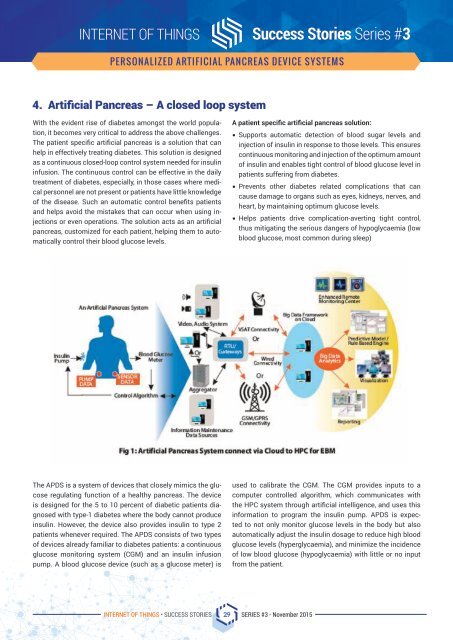Success Stories
VEZSJ
VEZSJ
You also want an ePaper? Increase the reach of your titles
YUMPU automatically turns print PDFs into web optimized ePapers that Google loves.
Internet of Things <strong>Success</strong> <strong>Stories</strong> Series #3<br />
Personalized Artificial Pancreas Device Systems<br />
4. Artificial Pancreas – A closed loop system<br />
With the evident rise of diabetes amongst the world population,<br />
it becomes very critical to address the above challenges.<br />
The patient specific artificial pancreas is a solution that can<br />
help in effectively treating diabetes. This solution is designed<br />
as a continuous closed-loop control system needed for insulin<br />
infusion. The continuous control can be effective in the daily<br />
treatment of diabetes, especially, in those cases where medical<br />
personnel are not present or patients have little knowledge<br />
of the disease. Such an automatic control benefits patients<br />
and helps avoid the mistakes that can occur when using injections<br />
or even operations. The solution acts as an artificial<br />
pancreas, customized for each patient, helping them to automatically<br />
control their blood glucose levels.<br />
A patient specific artificial pancreas solution:<br />
• Supports automatic detection of blood sugar levels and<br />
injection of insulin in response to those levels. This ensures<br />
continuous monitoring and injection of the optimum amount<br />
of insulin and enables tight control of blood glucose level in<br />
patients suffering from diabetes.<br />
• Prevents other diabetes related complications that can<br />
cause damage to organs such as eyes, kidneys, nerves, and<br />
heart, by maintaining optimum glucose levels.<br />
• Helps patients drive complication-averting tight control,<br />
thus mitigating the serious dangers of hypoglycaemia (low<br />
blood glucose, most common during sleep)<br />
The APDS is a system of devices that closely mimics the glucose<br />
regulating function of a healthy pancreas. The device<br />
is designed for the 5 to 10 percent of diabetic patients diagnosed<br />
with type-1 diabetes where the body cannot produce<br />
insulin. However, the device also provides insulin to type 2<br />
patients whenever required. The APDS consists of two types<br />
of devices already familiar to diabetes patients: a continuous<br />
glucose monitoring system (CGM) and an insulin infusion<br />
pump. A blood glucose device (such as a glucose meter) is<br />
used to calibrate the CGM. The CGM provides inputs to a<br />
computer controlled algorithm, which communicates with<br />
the HPC system through artificial intelligence, and uses this<br />
information to program the insulin pump. APDS is expected<br />
to not only monitor glucose levels in the body but also<br />
automatically adjust the insulin dosage to reduce high blood<br />
glucose levels (hyperglycaemia), and minimize the incidence<br />
of low blood glucose (hypoglycaemia) with little or no input<br />
from the patient.<br />
Internet of Things • <strong>Success</strong> <strong>Stories</strong> 29 SERIES #3 - November 2015









